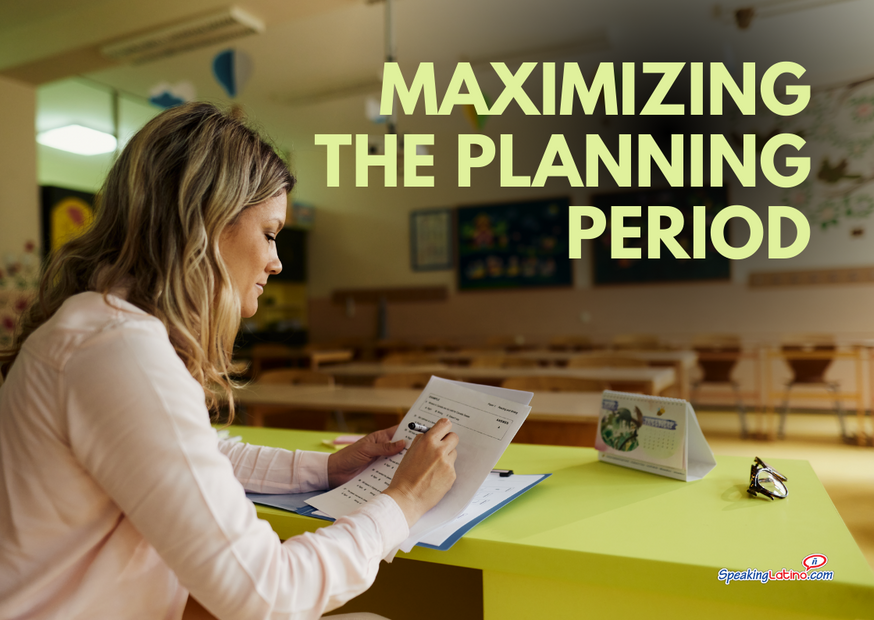
The demands of the school teaching profession can often lead to overwhelming workloads and challenges in maintaining a healthy work-life balance. One crucial aspect of a teacher's day is the planning period, a valuable time for preparation, grading, and organization.
Let’s explore effective strategies shared at the World Language Teacher Lounge Facebook group to help teachers maximize their planning period and prevent burnout.
How to Maximize Your Teacher Planning Period
Many teachers express the desire to avoid taking work home, highlighting the need for efficient use of the planning period. Michelle S. acknowledges the challenge of not taking work home but emphasizes the importance of planning. By utilizing the planning period effectively, teachers can reduce the need to bring work home and maintain a better work-life balance.
Let's see what teachers are doing to make the most out their planning time at school:
Implementing Self-Grading Techniques
To manage workload effectively, teachers can benefit from implementing self-grading and alternative assessment methods. Carolina B. suggests minimizing grading as a key strategy. By involving students in the grading process through self-assessment or peer grading, teachers can save time and provide immediate feedback, enhancing student engagement and reducing grading workload. She suggested using the first 5 minutes in class for students to grade assignments themselves, providing feedback and saving time.
Utilizing Proficiency-Based Grading
Kathy R. highlighted the benefits of proficiency-based grading, focusing on oral assessments instead of written assignments at novice and intermediate levels.
Arriving Early for Preparation
Diana S. recommended arriving at school early to complete tasks like copying, grade entering, and other essential activities before the start of the day.
Setting Clear Goals for Planning Periods
Teachers emphasized the importance of setting daily and weekly goals for planning periods to stay organized and focused on tasks at hand.
Minimizing Distractions
Anne T. mentioned closing the door and avoiding unnecessary conversations to maintain focus during planning periods.
Prioritizing Tasks
Armida G. suggested creating a daily list of essential tasks and a secondary list of tasks if time permits, to prioritize workload effectively.
Promoting Self-Assessment with Rubrics
Jaime B. recommended having students self-assess using rubrics to encourage responsibility for their educational outcomes.
Avoiding Social Distractions
LaVonne D. advised setting boundaries with colleagues and redirecting social interactions to maintain productivity during planning periods.
Creating To-Do Lists
One common theme among teachers is the importance of setting priorities and managing time effectively during the planning period. Mayra F. emphasizes the use of a to-do list in order of importance to stay on task and avoid distractions. By prioritizing tasks and tackling them systematically, teachers can make the most of their planning period without feeling overwhelmed.
Creating Boundaries for Work-Life Balance
Maintaining boundaries between work and personal time is essential to prevent burnout and promote well-being. Heather W. advises closing the door during planning periods to increase productivity at school and allow for necessary downtime. By setting clear work hours, limiting work-related communication outside of work, and prioritizing self-care, teachers can establish boundaries and protect personal time.
FAQ About Maximizing Teacher Planning Period
1. What are some effective approaches for reducing workload and avoiding taking work home?
- Minimize Grading: Consider strategies like self-grading, peer grading, or using formative assessment tools to reduce the amount of grading.
- Efficient Planning: Use planning periods at school wisely to organize, plan lessons, and grade papers.
- Set Boundaries: Close your door during planning periods to focus on tasks without interruptions.
- Utilize Technology: Use tools like Google Forms, Edpuzzle, or other online platforms for self-grading and assessments to save time.
- Prioritize Tasks: Identify must-do tasks for the day and allocate specific time slots for grading, planning, and administrative work.
- Avoid Distractions: Limit checking emails during planning periods to stay focused on essential tasks.
- Collaborate with Colleagues: Use department planning periods to discuss and share workload, ideas, and resources with colleagues.
2. How can implementing self-grading and alternative assessment methods help teachers manage their workload?

Self-grading provides immediate feedback to students.
- Time Efficiency: Self-grading allows students to assess their own work, reducing the time teachers spend grading assignments.
- Immediate Feedback: Self-grading provides immediate feedback to students, enabling them to reflect on their performance and make corrections independently.
- Peer Learning: Peer grading encourages collaboration and peer-to-peer learning, fostering a supportive classroom environment while reducing the teacher's grading load.
- Formative Assessment: Alternative assessment methods, such as project-based assessments or oral interviews, provide a more holistic view of student understanding without the need for extensive written grading.
- Differentiated Instruction: Alternative assessments allow teachers to assess students' understanding through various methods, catering to different learning styles and abilities.
- Reduced Paperwork: By incorporating digital tools for self-grading and alternative assessments, teachers can streamline the grading process and reduce paperwork.
- Focus on Learning Outcomes: Alternative assessments focus on assessing students' mastery of content and skills rather than just completion of tasks, leading to a more meaningful evaluation of student progress.
3. What are some tips for creating boundaries between work and personal time to prevent burnout?
Creating boundaries between work and personal time is crucial to prevent burnout. Here are some tips to help teachers maintain a healthy work-life balance:
- Establish Clear Work Hours: Define specific work hours and stick to them to avoid working beyond designated times.
- Set Realistic Expectations: Prioritize tasks and set achievable goals to prevent feeling overwhelmed by workload demands.
- Designate Personal Time: Schedule regular breaks and allocate time for personal activities, hobbies, and relaxation to recharge and unwind.
- Limit Work-Related Communication: Avoid checking work emails or messages outside of work hours to create a clear boundary between work and personal life.
- Practice Self-Care: Engage in activities that promote physical and mental well-being, such as exercise, meditation, or spending time with loved ones.
- Delegate Tasks: Delegate responsibilities when possible and collaborate with colleagues to share the workload and prevent burnout.
- Learn to Say No: Set boundaries by politely declining additional tasks or commitments that may encroach on personal time.
- Seek Support: Reach out to mentors, counselors, or support groups for guidance and encouragement in managing stress and maintaining balance.
The Perfect Combination to Maximize the Planning Period
Maximizing a teacher's planning period and achieving work-life balance requires a combination of effective time management, self-care practices, collaboration, and boundary-setting.
By implementing strategies such as setting priorities, utilizing self-grading methods, creating boundaries, and seeking support, teachers can enhance productivity, reduce workload, and prevent burnout.
Through a holistic approach to planning and self-care, teachers can navigate the demands of the profession while maintaining a healthy work-life balance.